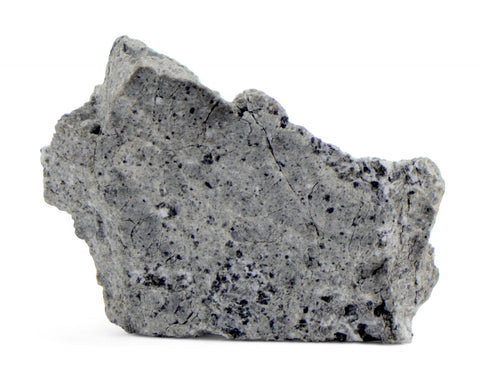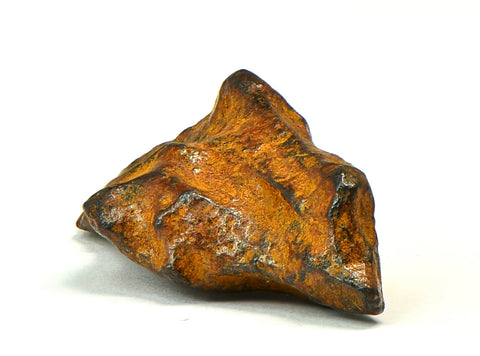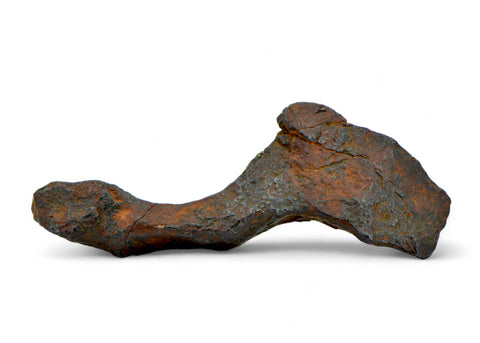18.5g MUNDRABILLA meteorite - Iron Meteorite
On Offer: 18.5 gram Mundrabilla Meteorite complete individual.
Official Name: Mundrabilla
First Found date: 1911
Location of find: Nullabor Plain, Western Australia
Description:
This is a 18.5 gram complete specimen of the Mundrabilla Iron Meteorite from Australia. This Meteorite was first discovered in 1911 and re-discovered in 1966 by geologists R. B. Wilson and A. M. Cooney while engaged on a geological survey. Two large masses (12.4 and 5.44 tonnes), were found near the Trans-Australian Railways on the Nullarbor plain.
Their unusual shapes include holes and large depressions. When this unique meteorite is cut and etched, it displays a beautiful medium octahedrite pattern along with troilite, with inclusions of schreibersite, graphite and silicate inclusions. This meteorite is a great addition to any collection and makes a great gift.
What you get: 18.5 gram Mundrabilla meteorite as shown, shipping/storage membrane box & signed Certificate of Authenticity.
We offer a 100% no questions asked 30 day return policy.
SEE OFFICIAL METEORITICAL SOCIETY ENTRY BELOW
| Mundrabilla | |||||||||||||||||||||
|---|---|---|---|---|---|---|---|---|---|---|---|---|---|---|---|---|---|---|---|---|---|
| Basic information |
Name: Mundrabilla This is an OFFICIAL meteorite name. Abbreviation: There is no official abbreviation for this meteorite. Observed fall: No Year found: 1911 Country: Australia Mass: 24 t |
||||||||||||||||||||
| Classification history: |
This is 1 of 68 approved meteorites classified as Iron, IAB-ung. |
||||||||||||||||||||
| Writeup |
Writeup from MB40: DISCOVERY OF MUNDRABILLA IRON METEORITE, WESTERN AUSTRALIA Name: MUNDRABILLA. The place of fall or discovery: The Nullarbor Plain, to the north of the Transcontinental Railway,Western Australia; φ = 30°47'S, λ =127°33'E. Date of fall or discovery: FOUND, March 1966. Class and type: IRON, medium octahedrite. Number of individual specimens: 2 Total weight: 10-12 tons and 5 1/2 tons. Circumstances of the fall or discovery: The meteorites were found by geologists R. B. Wilson and A. M. Cooney while engaged on a geological survey. Both masses are lying within only very slight depressions in clayey soil, some 180 m apart. The larger mass tends to have a crude conical to hemispherical shape with the nose partially buried in the soil. The axis is inclined at an angle of approximately 60°. Evidence of fragmentation of a larger mass is afforded by a sharp, angular, vertical face on the larger mass, which matches both in size and shape, a similar sharp face on the smaller mass. Preliminary study indicates that the meteorite came from the west at relatively low velocity and high angle. The larger mass has been presented to the Western Australian Museum, while the smaller mass is in Geosurveys possesion (Adelaide, South Australia). Source: Report of Dr. R. B. Wilson (Adelaide, South Australia) in a letter 1.4. 1967. Writeup from MB61: Warning: the following text was scanned and may contain character recognition errors. Refer to the original to be sure of accuracy. DISCOVERY OF FURTHER MASSES OF THE MUNDRABILLA, AUSTRALIA, IRON METEORITE Name: MUNDRABILLA Place of find: On the Nullarbor Plain, approximately 26 km NE. of the Mundrabilla siding on the Trans-Australian railway. The two masses were found 1.3 km apart. 127°45'S., 30°46'E. Date of find: 1979 Class and type: Iron. Anomalous. Number of individual specimens: 2 main masses and numerous small knuckle-shaped pieces. Total weight: 1640 kg approximately Circumstances of find: The two further large masses (no. 3 and no. 4 weighing 840 kg and 800 kg respectively) were found by Mr. A. J. Carlisle about 20 km east of the site where two Mundrabilla masses (no. 1 and no. 2) were found in 1966. Source: J.R. de Laeter, School of Physics and Geosciences, Western Australian Institute of Technology, Kent Street, Bentley, Western Australia, Australia. |
||||||||||||||||||||
| Buchwald | The following entries were found for Mundrabilla in Buchwald (1975) [Buchwald, Vagn F. (1975) Handbook of Iron Meteorites. University of California Press, 1418 pp.]
|
||||||||||||||||||||
| Catalogs: |
|
||||||||||||||||||||
We Also Recommend











